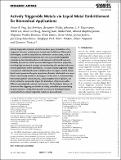Actively Triggerable Metals via Liquid Metal Embrittlement for Biomedical Applications
Author(s)
Feig, Vivian R; Remlova, Eva; Muller, Benjamin; Kuosmanen, Johannes LP; Lal, Nikhil; Ginzburg, Anna; Nan, Kewang; Patel, Ashka; Jebran, Ahmad Mujtaba; Bantwal, Meghana Prabhu; Fabian, Niora; Ishida, Keiko; Jenkins, Joshua; Rosenboom, Jan‐Georg; Park, Sanghyun; Madani, Wiam; Hayward, Alison; Traverso, Giovanni; ... Show more Show less
DownloadPublished version (1.921Mb)
Publisher with Creative Commons License
Publisher with Creative Commons License
Creative Commons Attribution
Terms of use
Metadata
Show full item recordAbstract
Actively triggerable materials, which break down upon introduction of an exogenous stimulus, enable precise control over the lifetime of biomedical technologies, as well as adaptation to unforeseen circumstances, such as changes to an established treatment plan. Yet, most actively triggerable materials are low-strength polymers and hydrogels with limited long-term durability. By contrast, metals possess advantageous functional properties, including high mechanical strength and conductivity, that are desirable across several applications within biomedicine. To realize actively triggerable metals, a mechanism called liquid metal embrittlement is leveraged, in which certain liquid metals penetrate the grain boundaries of certain solid metals and cause them to dramatically weaken or disintegrate. In this work, it is demonstrated that eutectic gallium indium (EGaIn), a biocompatible alloy of gallium, can be formulated to reproducibly trigger the breakdown of aluminum within different physiologically relevant environments. The breakdown behavior of aluminum after triggering can further be readily controlled by manipulating its grain structure. Finally, three possible use cases of biomedical devices constructed from actively triggerable metals are demonstrated.
Date issued
2022-11-02Department
Massachusetts Institute of Technology. Department of Mechanical EngineeringJournal
Advanced Materials
Publisher
Wiley
Citation
Feig, Vivian R, Remlova, Eva, Muller, Benjamin, Kuosmanen, Johannes LP, Lal, Nikhil et al. 2022. "Actively Triggerable Metals via Liquid Metal Embrittlement for Biomedical Applications." Advanced Materials.
Version: Final published version